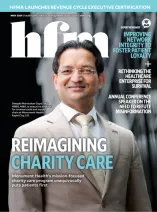Guidance for improving allocation of nursing resources highlighted in joint report
Although the relationship between nursing care and safe, high-quality patient care is widely understood today, it is often difficult for health care leaders to agree on a systematic method for allocating nursing resources, according to a new report published by the Healthcare Financial Management Association (HFMA). The report offers insight into the different perspectives that finance and nursing professionals bring to nurse staffing issues along with guidance for bridging the gap between the two groups.
Two leading nursing organizations — the American Nurses Association (ANA) and the American Organization for Nursing Leadership (AONL) — coauthored the report with HFMA. The report also was endorsed by the American Association of Critical-Care Nurses.
With 2020 declared the Year of the Nurse, this 19-page report is especially timely and critical in advancing an important nursing priority. It explores the different sources of stress that nursing and finance leaders routinely encounter in the course of their work. Enhancing mutual understanding of their respective professional roles and challenges can make it easier for the two groups to work together toward shared goals, according to the authors. The report, “The Business of Caring: Promoting Optimal Allocation of Nursing Resources,” also calls on health care leaders to pioneer creative nurse staffing approaches, assess the impacts of new technology on all phases of care, strive for fierce collaboration and agree on principles for allocating appropriate nursing resources for patient care. These principles include the following: (1) nurse staffing makes a critical difference for patients and for the care experience; (2) safe nurse staffing leads to better patient outcomes; and (3) optimal staffing reduces nurse turnover, which in turn reduces the cost of care.
“Finance and nursing leaders today realize that cutting nurse staff can work against efforts to improve quality of care and reduce costs,” said HFMA President and CEO Joseph J. Fifer, FHFMA, CPA. “By building on that shared understanding, I am confident that together we will make great strides in improving allocation of nursing resources.”
The authors emphasize that the patient experience should always be front and center amid efforts to improve collaboration between nursing and finance professionals.
“Nurses have a direct impact on quality of care and patient and family satisfaction. It is time to shift the nurse staffing paradigm so that the contributions of nurses to positive patient outcomes are understood, valued and viewed as a priority investment rather than a discretionary expense,” said ANA President Ernest J. Grant, PhD, RN, FAAN.
The report contrasts the confrontational conversations about nurse staffing budgets that nursing and finance leaders typically had in the 1980s with the more collaborative conversations that characterize contemporary working relationships between the two groups. “Providing safe and affordable health care is a top priority,” said AONL CEO Robyn Begley, DNP, RN, NEA-BC. “Health care leaders across the country are transforming health care delivery to improve outcomes, enhance the patient experience, lower the cost of care and foster a healthy work environment for all clinicians.”
A collaborative approach to nursing resource allocation will have benefits beyond improving staffing allocations, the authors write. Collaboration will help hospitals and health systems prioritize quality of care, consider organizational resource allocation holistically, yield more reliable data for decision-making, and prevent and resolve conflict, the authors conclude. These changes will benefit health systems, the people who work there and, most importantly, the patients they serve.
The report is available on the HFMA website.
About HFMA
The Healthcare Financial Management Association (HFMA) is the nation’s premier membership organization for healthcare finance leaders. HFMA builds and supports coalitions with other healthcare associations and industry groups to achieve consensus on solutions for the challenges the U.S. healthcare system faces today. Working with a broad cross-section of stakeholders, HFMA identifies gaps throughout the healthcare delivery system and bridges them through the establishment and sharing of knowledge and best practices. We help healthcare stakeholders achieve optimal results by creating and providing education, analysis, and practical tools and solutions. Our mission is to lead the financial management of health care.
About ANA
The American Nurses Association (ANA) is the premier organization representing the interests of the nation’s 4 million registered nurses. ANA advances the nursing profession by fostering high standards of nursing practice, promoting a safe and ethical work environment, bolstering the health and wellness of nurses, and advocating on health care issues that affect nurses and the public. ANA is at the forefront of improving the quality of health care for all. For more information, visit nursingworld.org.
About AONL
As the national professional organization of more than 10,000 nurse leaders, the American Organization for Nursing Leadership (AONL) is the voice of nursing leadership. AONL’s membership encompasses nurse leaders working in hospitals, health systems, academia and other care settings across the care continuum. Since 1967, the organization has led the field of nursing leadership through professional development, advocacy and research that advances nursing leadership practice and patient care. AONL is a subsidiary of the American Hospital Association. For more information, visit AONL.org.





